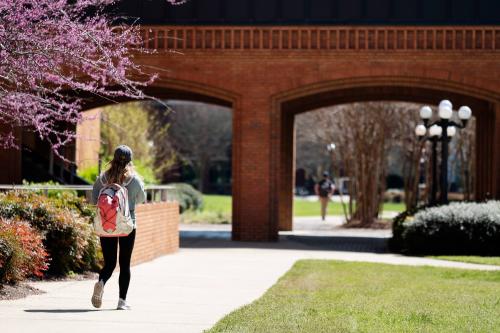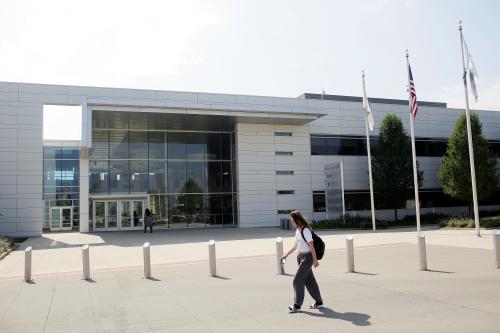The fiscal distress brought on by the coronavirus pandemic has sparked ongoing discussion about the failure of elite, private universities to use their large endowments to avert steep cuts. Coupled with the recent sentencing of Lori Laughlin in the Varsity Blues scandal, it’s easy to forget that most students don’t attend these types of institutions. In 2018, private, four-year colleges accounted for just 20 percent of total freshman enrollment, as compared to 45 percent for public, four-year colleges and universities.[1] Public four-years go beyond enrolling many students, however – they are the workhorses of upward mobility for the middle class.
In our new report, which draws on data produced by Opportunity Insights, we show that students who attend college – particularly a four-year college – are significantly more likely to experience upward mobility in adulthood, relative to their parents’ position in the income distribution, than nonattenders. Both public and private four-year colleges have high rates of Middle-Class Mobility – the share of students at a college who come from the middle quintile of the income distribution (access) and move up at least one quintile in adulthood (success) – but public colleges contribute substantially more to upward mobility overall because they enroll many more students.
Access to college overall—and four-year colleges in particular—is highly dependent on parental income, however Figure 1 show the strong relationship between parental income and college attendance, and Figure 2 shows how the type of college attended varies with parental income. (These figures use the Opportunity Insights data and are for cohorts born in the early 1980s.) Less than half of children growing up in the poorest fifth of households (quintile 1) attend college, compared to 92 percent of children whose parents are in the top quintile.

Not only are lower-income and middle class people less likely to attend college, Figure 2 shows that they are less likely to attend a four-year college when they do. Only 46 percent of children from low-income families enroll in four-year colleges—with 36 percent in public and 10 percent in private—compared to 76 percent of their more-affluent peers. And most four-year college students attend public colleges: Outside of the top income quintile, four-year college students are 3 to 4 times more likely to be attending a public rather than private college.

Figure 3 shows the share of total enrollment, spending, and upward mobility each sector accounts for, separately for the bottom quintile and the middle class. (See our report for details on how we calculate these). Public four-year colleges account for 40 percent of enrollment, 54 percent of spending, and 48 percent of upward mobility. Two-year colleges account for a similar share of enrollment, a small share of spending—due to their low per-pupil cost—and about a third of upward mobility for the middle class. The patterns are broadly similar for the bottom quintile, though low-income students are less likely to attend four-year and more likely to attend two-year colleges, compared to middle class students.

But would those who attend four-year colleges have experienced upward mobility regardless of whether and where they went to college? Selection into four-year colleges—that is, differences in other characteristics, such as academic achievement, between four-year attenders and others—does not appear to account for most or all of the greater upward mobility in that group. Evidence that many students benefit from attending a public four-year college is mounting:
- A new study using data from Georgia shows that enrolling in a public four-year boosts students’ household income at age 30 by 20 percent and has even larger impacts for those from low-income high schools for students with SAT scores around the threshold for access to four-year public colleges in the state.
- Another recent study finds that for low-income students and underrepresented minorities, admission to four-year public colleges displaces two-year public college enrollment, four-year private college enrollment, and no college enrollment almost equally. Admission to four-year public colleges increases mean annual earnings by almost $8,000 eight to fourteen years after applying without increasing the private costs of college.
- A study on gaining access to a selective University of California campus finds that a “top percent” policy boosts the probability of earning a college degree within 5 years by 22% and early-career earnings by $15,000.
- Finally, the most recent higher education study from Opportunity Insights uses IRS data linked to data from the College Board and ACT and shows that much of the difference in outcomes across colleges is a causal effect of the college and not just due to selection.
Our report shows that moderately selective public colleges play a critical role in promoting upward mobility for students from the middle class and that two-year colleges offer good value for society. State and federal policymakers should work to ensure both types of public colleges have the capacity to effectively serve all students who want to attend.
The pandemic has caused a massive shift towards online learning that could increase access for middle-class students. But ensuring access does not guarantee success. Many institutions have struggled to adjust to the new online environment, which has negatively affected students’ performance. As the fall semester looms ahead and students are increasingly worried about their future job outcomes because of the pandemic, public colleges are as critical as ever.
Cuts to higher education in the coming years are inevitable considering the depth of the current fiscal crisis. State government’s revenues are down dramatically, and many middle-class and low-income families will not be able to afford tuition increases in the current economic climate. Assistance from the federal government will be needed to ensure access and quality in public colleges—which play such an important role in upward mobility—until the pandemic comes under control and the economic situation improves.
[1] U.S. Department of Education, National Center for Education Statistics, Higher Education General Information Survey (HEGIS), “Fall Enrollment in Colleges and Universities” surveys, 1970 through 1985; Integrated Postsecondary Education Data System (IPEDS), “Fall Enrollment Survey” (IPEDS-EF:86-99); IPEDS Spring 2001 through Spring 2019, Fall Enrollment component; and Enrollment in Degree-Granting Institutions Projection Model, 2000 through 2029. (This table was prepared December 2019.)
Post updated on July 24, 2020 with updated Figures 2 and 3.








Commentary
Public colleges are the workhorses of Middle-Class Mobility
July 22, 2020